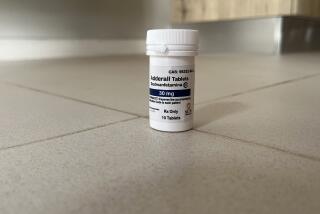Emergency room visits for ADHD medications rise sharply, report says

- Share via
Problems with stimulant medications used to treat symptoms of attention deficit and hyperactivity disorder (ADHD) are sending an increasing number of Americans to emergency departments for treatment, a new government report warns.
Between 2005 and 2010, a study finds, ADHD medication-related emergency room visits have more than doubled — from 13,379 in 2005 to 31,244 in 2010. While emergencies associated with ADHD medications rose slightly among children, the hike has been particularly pronounced in those over 18.
The new data were reported Thursday in an issue of the DAWN (Drug Abuse Warning Network) Report, published by the Substance Abuse and Mental Health Services Administration, an office of the National Institutes of Health.
Half of the stimulant-related emergency department visits--15,585 in 2010-- were for “non-medical” use of ADHD medication: They were to treat stimulant-related effects in patients who either had not been diagnosed with ADHD and prescribed the drugs or in patients who were not taking the medication as prescribed.
The report identified 29% of the 2010 visits as related to an “adverse reaction” to an ADHD stimulant medication.
The news of the steep rise in stimulant-related problems comes as a generation of children diagnosed in large numbers with ADHD navigates the transition to adulthood. The rise of emergency-department visits connected with stimulant medication was steepest by far in young adults--ages 18 to 25. There were 8,148 trips to the emergency room among patients in this age group in 2010--up from 2,131 in 2005.
The news comes against the backdrop of a recent government report showing that between 2006 and 2010, non-medical use of Adderall, a common stimulant prescribed for ADHD symptoms, was up sharply among young adults between 18 and 25.
Many of the nation’s 5.4 million kids estimated to suffer from symptoms of ADHD will mature out of its symptoms of inattention and hyperactivity. But as many as four in five may continue to have difficulties with attention into adulthood, by some estimates.
But stimulant-related emergency room visits have also risen sharply among older patients. Among patients 26 to 34, there were 6,094 emergency department visits related to ADHD stimulants in 2010 (up from 1,754 in 2005). Among those over 35, there were 7,957 such visits in 2010 (up from 2,519 in 2005).
While 37% of the visits involved only the use of stimulants, 63% involved the use of stimulants and at least one other drug--most often a pharmaceutical (rather than an illicit) drug. Rouhly one in four cases involved the concurrent use of ADHD stimulant medications with anti-anxiety or insomnia medications. One in five cases involved the concomitant use of alcohol.
“As treatment for ADHD among adults becomes more widespread, prescribing physicians (including psychiatrists and other mental health professionals) may carefully consider associated risks among those who have chronic health conditions and/or take other medications that may interact with ADHD stimulant medications,” the report noted. “A variety of treatment options, both pharmaceutical and nonpharmaceutical, are available for adults with ADHD.”
More to Read
Sign up for Essential California
The most important California stories and recommendations in your inbox every morning.
You may occasionally receive promotional content from the Los Angeles Times.










